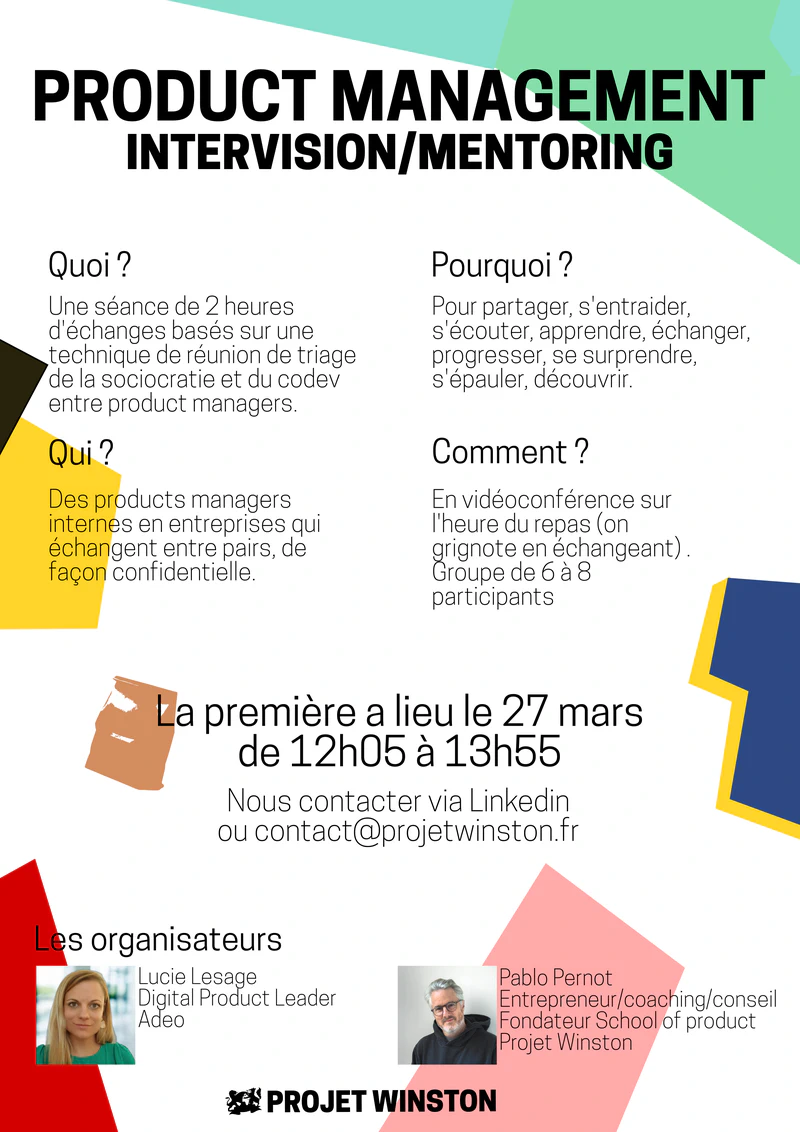Thursday, March 27th, we’re organizing an intervision/mentoring session which I hope will be followed by others.
We? I’m reuniting in this adventure with Lucie Lesage who had also joined us, along with Dragos Dreptate, during the first meetups of the School of Product (you know, the product conference with Frankenstein and a cigar as its symbol/logo) at benext.
One or more intervision/mentoring sessions around product management - what is it? How does it work?
Well, imagine five to seven, or even eight people (but that starts to be too many), around a virtual table: via videoconference in this case. These people will share challenges they’re facing, thus providing an opportunity for others to enrich our points of view, or quite simply, and this is important, make us understand that we’re not alone in this situation.
It can be similar to codev. Plenty of words to describe the same things. I prefer intervision and mentoring, because two of us are there to organize the discussions, and potentially help “a bit more,” but this last point remains to be proven. The two I’m talking about are Lucie and me.
We organize the discussions like a sociocracy triage meeting, but always in our own way. In a few words:
- Each person in turn proposes a keyword that represents their topic. The topic they want to share, and for which they hope to receive feedback, points of view, information, interesting insights. This word can be enigmatic or obvious. What’s important for us is to gauge the number of topics. It’s not necessary to have a topic to come. You can have plenty of topics, but you deliver them one by one at each round.
- We end up with a list of keywords. We usually manage to address between two and four keywords per two-hour session. The session will repeat and we hope to address all requests over time. As a precaution, the facilitator asks if a topic needs to be addressed urgently. If so, we start with it, otherwise in the order the topics arrived.
- Let’s say we start with Juliette’s topic who gave the word “balance.”
- She takes 5 to 10min to explain and describe her topic, generally a challenge. And if she can, she already proposes her next actions related to this topic.
- We do one or more clarification rounds. This means that each person (virtual round table) can ask questions (and only questions, no analysis, no problem-solving) to clarify the topic. When the questions are exhausted, we move to the next round. No one is obligated to have questions, no one should feel obligated to have questions (that’s the worst).
- We do a reaction round. This means that each person in turn reacts. They give their analysis, their vision, what they would do, their opinion on Juliette’s proposals, they give leads, tools, practices, or they explain that they’re in the same situation as Juliette and experiencing the same emotions, etc. Or they simply pass their turn.
- Back to Juliette who shares what she’s taking from each intervention in her basket to bring back to her context.
- We move to the next topic.
Having practiced this format for several years at benext and around at clients, I find it perfectly suitable. The quality of maintaining the framework can vary depending on our state of mind, but it has worked very well and I know that those who experienced it will continue to use it.
For now, I believe we are five. There are two or three spots left until March 27th. You can register by writing to us directly to each of us, or by using contact@projetwinston.fr. You must necessarily have a connection to product management and not be a person from a service company, a freelancer, or something like that. You’ll know how to answer this question. We want to guarantee peer perspectives and calmness (no soliciting) in these sessions. Moreover, these sessions are confidential: we don’t say who participates, nor naturally the content that is shared there.

That Thursday, we grab our sandwich and meet in videoconference.
Learn more about sociocracy: